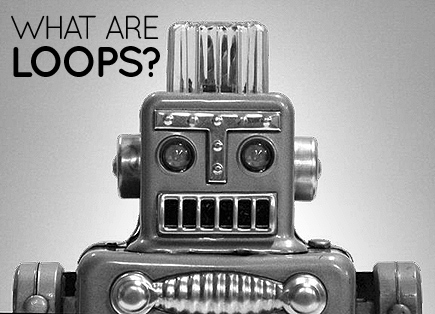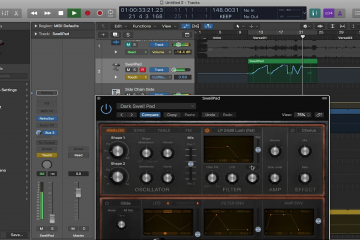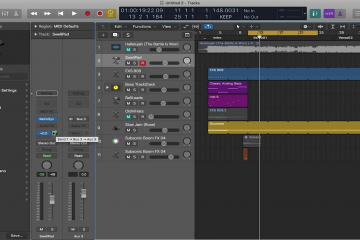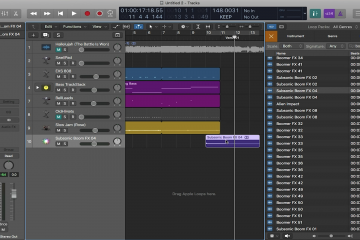What ARE Loops?

Wow, where to begin?
Let’s Start With Early Sequencers and Trackers.
The first analog sequencers played rigid patterns of notes using a grid of (usually) 16 buttons, or steps, each step being 1/16 of a measure. These patterns of notes were then chained together to form longer compositions. Sequencers of this kind are still in use, mostly built into drum machines and groove boxes, and are now called step sequencers. They are monophonic by nature, although some are multitimbral, meaning that they can control several different sounds but only play one note on each of those sounds.
In 1977, the Roland Corporation released the MC-8 Micro composer, the first microprocessor-based digital sequencer. Considered revolutionary at the time, it introduced features such as a keypad to enter note information and 16 KB of RAM which allowed a maximum sequence length of 5200 notes, a huge step forward from the 8-16 step sequencers at the time. It also allowed the user to allocate multiple pitch CVs to a single gate channel, creating polyphonic parts within the overall sequence. Described by Roland as a computer music composer, the earliest known band to utilize it was the electronic music group Yellow Magic Orchestra in 1978, helping them create new sounds not possible until then.
In 1979, the Fairlight CMI’s built-in sequencer, known as Page R, combined step sequencing with sample playback. This led to the development of similar software sequencers of this kind, called trackers, which were popular in the 1980s and 1990s as simple sequencers for creating computer game music and the like.
Modern sequencers.
With the advent of MIDI and in particular the Atari ST, programmers were able to write software that could record and play back the notes played by a musician. Unlike the early sequencers, which played mechanical sounding notes of exactly equal length, the new ones recorded and played back expressive performances by real musicians. These were typically used to control external synthesizers, especially rack mounted sound modules as it was no longer necessary for each synthesizer to have its own keyboard.
As the technology matured, sequencers gained more features, including the ability to record multitrack audio. Sequencers used primarily for audio are often called digital audio workstations (or DAWs). Many modern sequencers can also control virtual instruments implemented as software plug-ins, allowing musicians to replace separate synthesizers with software equivalents.
Although the term “sequencer” is today used primarily for software, workstation keyboards include their own proprietary built-in MIDI sequencers. Drum machines and some older synthesizers have their own step sequencer built in. There is still also standalone hardware MIDI sequencers, although the market demand for those has diminished greatly due to the greater feature set of their software counterparts.
One of those counter parts is software like Reason, Ableton, and many more. We are still in the infancy with software based recording and sequencing. They reason I say that is because we do not have a solid foundation built to cross support all software apps for a seamless transfer from one package to another.
Cross support or “Generalizing” (I will call it this from now on) was done in the hardware field and we called it “General MIDI”. Starting sometime in the early 90’s you began to see this logo appearing on most keyboards. In fact if you look hard enough you may still find this logo on your keyboard or recording device somewhere.
What generalizing did was create a standard programming set for an instrument on a device. Let’s see if I can remember… track 170 was set for drums or something like that while track 01 02 03 were piano’s. So what this meant is if you made a song or as we now call them loops and saved it in a general file any device that had a general MIDI sound bank would play correctly or with minimal changes. NEAT NOTE: The computer you are using to view this also has a General MIDI synthesizer built into the sound card. Want to test it? Click HERE to hear a MIDI version of As The Deer and the same song imported into Reason HERE. Notice the difference? Quite a change huh? With reason and many other software applications the sounds are generated using samples. That is another blog all together.
Here we are talking about what loops are and to answer that question I had to explain the history of using them. Really too truly answer the question is basically this. Loops are computer generated, perfectly timed renditions of the full or partial accompaniment of a song. They are triggered by the musician using a computer or trigger device. They play from point A to point B. They can be used to just add a click track usually paned to the left side of a stereo signal or a full bodied sound to fill in parts where there are no musicians to play the parts. It is that simple.
I know this blog was long but I wanted to be through with the history and samples of how the quality has changed for the better over the years. The David Crowder Band uses loops as do many artists today. Loops are not new they have been around as long almost as recording has been. Another funny note is click tracks have been around since the first metronome was invented.
About the author: Scott Pearson (Username: ToHimAlone) is one of LC’s most active members. When he creates loops, the goal is to recreate a full band sound for churches that are missing members or parts. He is launching a world-wide youth group called To Him Alone Youth. His vision for To Him Alone Youth is to run a year-round camp dedicated to worship and teaching youth how to share the gospel of Jesus Christ. Find out more details and listen to his loops on his seller page.




2 Comments
Brandon Pearce · October 9, 2011 at 1:36 pm
Hey Scott,
I am a sophomore in my undergraduate Music major with a focus in Worship Arts at Toccoa Falls College, a small bible college in NE Georgia. I just wanted to say thanks for the info. I’m trying to learn on my own the kind of technological knowledge that it takes to produce quality sound with programs like Reason and Ableton. I have a heart for worship, and I hope to work in a church or christian education setting some day running audio technology and making my Savior proud by producing some beautiful music for Him.
Any words of advice as I dive into the world of technology and ministry?
Your brother in Christ,
-Brandon
Scott Pearson · November 12, 2011 at 10:30 pm
Brandon,
My advice to you is very simple. If you keep in mind it is a privilege to serve and give of yourself you will be fine. Too many times we as worship leaders and servants have the mind set of “I have to do this. I have to do that.” Our response as leaders should be “I get to” I get to lead worship or I get to serve. If we as leaders could remind ourselves each day to give all we are to Christ then we will project salvation and the joy of serving. On the technology side I would suggest letting your love of Christ motivate you. Look at 1 Corinthians 10:31. Live that scripture. God bless you and keep you.
You’re Brother in Christ.
Scott Pearson